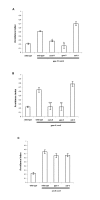Expression of mammalian GPCRs in C. elegans generates novel behavioural responses to human ligands
- PMID: 16857046
- PMCID: PMC1550261
- DOI: 10.1186/1741-7007-4-22
Expression of mammalian GPCRs in C. elegans generates novel behavioural responses to human ligands
Abstract
Background: G-protein-coupled receptors (GPCRs) play a crucial role in many biological processes and represent a major class of drug targets. However, purification of GPCRs for biochemical study is difficult and current methods of studying receptor-ligand interactions involve in vitro systems. Caenorhabditis elegans is a soil-dwelling, bacteria-feeding nematode that uses GPCRs expressed in chemosensory neurons to detect bacteria and environmental compounds, making this an ideal system for studying in vivo GPCR-ligand interactions. We sought to test this by functionally expressing two medically important mammalian GPCRs, somatostatin receptor 2 (Sstr2) and chemokine receptor 5 (CCR5) in the gustatory neurons of C. elegans.
Results: Expression of Sstr2 and CCR5 in gustatory neurons allow C. elegans to specifically detect and respond to somatostatin and MIP-1alpha respectively in a robust avoidance assay. We demonstrate that mammalian heterologous GPCRs can signal via different endogenous Galpha subunits in C. elegans, depending on which cells it is expressed in. Furthermore, pre-exposure of GPCR transgenic animals to its ligand leads to receptor desensitisation and behavioural adaptation to subsequent ligand exposure, providing further evidence of integration of the mammalian GPCRs into the C. elegans sensory signalling machinery. In structure-function studies using a panel of somatostatin-14 analogues, we identified key residues involved in the interaction of somatostatin-14 with Sstr2.
Conclusion: Our results illustrate a remarkable evolutionary plasticity in interactions between mammalian GPCRs and C. elegans signalling machinery, spanning 800 million years of evolution. This in vivo system, which imparts novel avoidance behaviour on C. elegans, thus provides a simple means of studying and screening interaction of GPCRs with extracellular agonists, antagonists and intracellular binding partners.
Figures




References
-
- Bargmann CI, Mori I. Chemotaxis and thermotaxis. In: Riddle DL, Blumenthal T, Meyer BJ, Priess JR, editor. C elegans II. Vol. 25. Cold Spring Harbour, NY: Cold Spring Harbour Laboratory Press; 1997. pp. 717–737. - PubMed
-
- Milani N, Guarin E, Renfer E, Nef P, Andres-Barquin PJ. Functional expression of a mammalian olfactory receptor in Caenorhabditis elegans. Chem Neurosci. 2002;13:2515–2520. - PubMed
Publication types
MeSH terms
Substances
Grants and funding
LinkOut - more resources
Full Text Sources
Other Literature Sources

